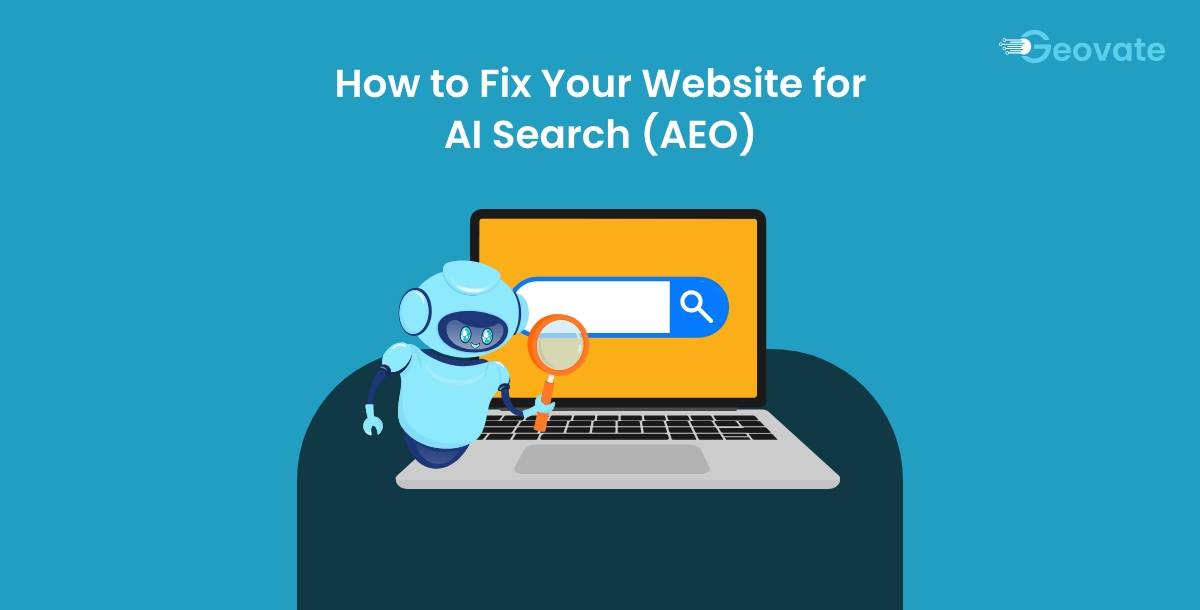How to Fix Your Website for AI Search (AEO) in 2025 ?
Wed,01 Oct 2025 12:21:00- Font Size
- Share Content

Artificial intelligence has changed how people search online. Tools like ChatGPT, Perplexity AI, and Google’s AI Overviews don’t just list links anymore — they generate direct answers. If your website isn’t prepared for this shift, you risk losing visibility, traffic, and customers.
That’s where AEO (Answer Engine Optimization / AI Search Optimization) comes in.
In this guide, we’ll cover:
- What AEO is and how it differs from SEO
- Why AI search matters for your business
- 8 practical steps to make your website AI-friendly
- Real-world examples of how AEO works
- A checklist to track your optimization progress
By the end, you’ll have a clear roadmap to future-proof your website for AI-driven search.
What is Answer Engine Optimization (AEO) ?
Answer Engine Optimization (AEO) is the process of making your website content easier for AI search engines to understand, reference, and recommend in AI-generated answers.
Think of it this way:
- Traditional SEO → Competing for rankings on Google’s “10 blue links”
- AEO → Competing to be the source that AI cites when generating an answer
AI search engines don’t just crawl; they interpret. They pull from structured data, metadata, and high-quality context to produce summaries. If your site isn’t machine-readable, you’re invisible.
SEO vs AEO: What’s the Difference?
Factor | SEO (Search Engine Optimization) | AEO (Answer Engine Optimization) |
Goal | Rank on SERPs (Search Engine Results Pages) | Be cited in AI-generated answers |
Output | Blue links + snippets | Conversational answers, AI citations |
Key Signals | Keywords, backlinks, on-page SEO | Schema markup, structured content, trustworthiness |
User Intent | Click-through to site | Direct answer delivery (sometimes without a click) |
Traditional SEO focuses on optimizing your website to rank higher on Google’s search engine results pages, while AEO (Answer Engine Optimization) goes one step further by making your content understandable and trustworthy for AI-driven platforms like ChatGPT, Perplexity, and Google AI Overviews.
In SEO, the primary goal is to attract clicks through keyword targeting, backlinks, and content relevance, whereas in AEO the goal is to become a trusted source that AI search engines directly quote or recommend in conversational answers. This means structured data, schema markup, and machine-readable signals carry more weight in AEO compared to traditional SEO. Businesses that invest in AISEO Services or specialized Answer Engine Optimization Services are better positioned to future-proof their online visibility, ensuring they not only rank well in search engines but also stand out in the rapidly growing world of AI-powered search.
In short: SEO gets you found. AEO gets you quoted by AI.
8 Steps to Fix Your Website for AI Search
1. Build on a Strong Technical Framework
A weak technical foundation makes your site invisible to crawlers.
- Use platforms like WordPress, Webflow, or Next.js that output clean HTML.
- Avoid heavy reliance on JavaScript for core content (many crawlers struggle).
- Test with Google’s Mobile-Friendly Test to ensure responsive design.
Pro Tip: Think of your site like a house. Without strong foundations, nothing else matters.
2. Add Structured Data (Schema Markup)
Structured data is the language AI search understands best.
Use Schema.org markup to identify content types:
- Blog posts → Article schema
- Product pages → Product schema (with offers and reviews)
- FAQ pages → FAQPage schema
- Local businesses → LocalBusiness schema
Example:
{
"@context": "https://schema.org",
"@type": "Article",
"headline": "How to Fix Your Website for AI Search (AEO)",
"author": {
"@type": "Person",
"name": "David"
},
"datePublished": "2025-01-01",
"publisher": {
"@type": "Organization",
"name": "David Blog"
}
}
This makes your content “AI-readable,” increasing chances of being cited in AI answers.
3. Optimize Meta Tags & Open Graph
Even in the AI era, meta data still matters.
- Title tag: Use your target keyword (“AI Search Optimization,” “AEO”).
- Meta description: Summarize content clearly in <160 characters.
- Open Graph tags: Ensure social previews look clean.
AI models often pull summaries directly from meta tags.
4. Clean Sitemap & Robots.txt
AI search relies on structured crawling.
- Generate an XML sitemap and submit it in Google Search Console.
- Keep robots.txt simple (don’t accidentally block key content).
- Audit for orphaned pages (pages with no internal links).
5. Ensure Crawlability & Indexability
If Google can’t see you, AI can’t either.
- Use “site:yourdomain.com” searches to check indexing.
- Avoid blocking scripts that render key content.
- Fix broken internal links and redirects.
Remember: AI search engines often start with Google’s index.
6. Test Your Presence in AI Search Tools
Don’t guess — check. Search your brand and content in:
- ChatGPT (with browsing enabled)
- Perplexity.ai
- Google AI Overviews
If you’re not showing up:
- Look at who is being cited.
- Analyze their schema, authority, and content style.
7. Speed & Performance Optimization
AI prefers fast-loading, mobile-first websites.
- Run audits with PageSpeed Insights.
- Compress images (WebP), enable caching, and minify scripts.
- Aim for Core Web Vitals (LCP < 2.5s, CLS < 0.1).
Fast sites = better user experience = more AI trust.
8. Monitor, Iterate, Improve
AI search is constantly evolving.
- Track AI traffic sources in analytics.
- Use tools like Ahrefs / SEMrush to monitor new AEO keywords.
- Re-test schema validity every quarter.
Treat AEO as an ongoing cycle, not a one-time fix.
Case Study: Schema in Action
Let’s take an example:
- A local restaurant’s site without schema shows up poorly in search.
- After adding LocalBusiness + Menu schema, it starts being cited in Perplexity AI results when users ask for “best Italian restaurants near me.”
Result: Increased visibility without relying on ads.
Quick AEO Checklist
- Strong, crawlable site framework
- Schema markup implemented (Article, FAQ, Product, LocalBusiness)
- Optimized meta & Open Graph tags
- XML sitemap + clean robots.txt
- Confirmed indexability in Google
- Tested presence in AI search engines
- Optimized Core Web Vitals (speed + mobile)
- Monitoring + continuous updates
The Future of AEO
The AI search landscape is evolving fast:
- ChatGPT plugins and Perplexity Pro are already changing discovery.
- Google is prioritizing AI Overviews in many queries.
- More AI-driven platforms will emerge in 2025.
By preparing now, you’ll secure early first-mover advantage in AI search visibility.
Conclusion
Optimizing your website for AI search isn’t just a nice-to-have anymore — it’s becoming a business necessity. As more users turn to tools like ChatGPT, Perplexity, and Google’s AI Overviews for quick, reliable answers, the competition isn’t just for rankings in traditional SERPs but for being cited and trusted by AI systems. That’s where AEO (Answer Engine Optimization) comes in.
By implementing the eight steps outlined in this guide — from choosing a strong technical framework and adding schema markup, to optimizing meta tags, crawlability, and site performance — you’re positioning your website as a trusted, machine-readable source that AI can confidently recommend. Remember, the future of search is conversational, and your content needs to be ready to participate in that dialogue.
The good news? Many of the foundational AEO strategies build on traditional SEO best practices, meaning you don’t have to reinvent the wheel. Instead, you’re enhancing what you already have by making it easier for AI models to understand, summarize, and highlight your content in their answers.
